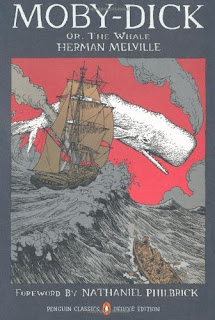
In my leisure reading over the years, I have generally found two types of books. There are books like The Yearling that are written in a way that makes me want to savor every word and a story that is compelling and beautiful as it unfolds. In The Yearling the story flows along with few excursions into material that might "sidetrack" me as I read. I know I'm getting into tricky territory now as I write about what I like in leisure reading. But remember, this is about my opinion. Your opinion may be quite different. Maybe you like to read a novel that explores the sidetracks as well as a flowing story.
Now that I have described my reading of The Yearling, I'll talk about a different kind of book, still fiction but different from the kind that sweeps you along on a story line with few excursions. Some years ago I read Moby-Dick by Herman Melville. This is considered one of the greatest works of American fiction and is well-worth reading. That said, I also have to point out that Moby-Dick is a good example of one of those novels that takes the reader on long excursions into rather lengthy discourses on many subjects having to do with whales and the whaling industry of the 19th century. For example, Melville gives the reader 11 pages of material on various kinds of pictures of whales and whaling, from engravings to paintings on wood. This sidetrack, if you wish to see it as such, comes in the middle of an interesting account of Captain Ahab's pursuit of the great white whale. It became a bit frustrating for me to be reading the interesting story and then be switched over to a lengthy treatise on pictures of whales or any number of other topics.
So, here is how I ended up reading Moby-Dick. I call this kind of pleasure reading "Following the Thread." I decide after starting a book like Moby-Dick that there is a thread of a good story that I want to follow. So, I set my purpose in reading to follow that story and enjoy the reading experience. I read the first chapter or two to discover the setting, plot, characters, and general idea of the book. By this point I have probably seen the author's intent as it was with Melville, to educate the reader on many aspects of whales and whaling as well as to tell the story. If I decide that my purpose in reading is to enjoy the story, I start following the thread and skimming through parts that strike me as excursions into areas that are not crucial to pursuing the story. I skim, which for me means to quickly glance over what is written and to search for where the story thread starts again. Once I find the thread, I read more carefully to enjoy the story. When the side excursion begins again, I start skimming once again in order to pick up the thread of the story. The way I read depends on my purpose and I find following the thread to be a flexible approach to reading when my purpose is to enjoy a good story.

The following the thread strategy helped me read Moby-Dick in about half the time it would have taken me to read it all straight through. I am currently using following the thread with American Pastoral by Philip Roth which won the Pulitzer in 1998. This book has a thread of a story that is embedded in a lot of material that strikes me as uninteresting and not very crucial to the story. I want to finish American Pastoral and get the satisfaction of the story Roth is telling but I can't handle the sidetracks. I know when I am encountering too many sidetracks because I feel like giving up on a novel. At that point I stop and ask myself if the story is worth experiencing and if it is the sidetracks that are leading me to want to quit. If both of these points is true, I then decide my purpose is to read the story and I start following the thread.
Before I leave my discussion of following the thread, I would like to add that the strategy might apply to academic or professional reading as well as to leisure reading. In non-leisure reading, I find myself skimming through material and sampling what is there and then picking up on the thread of the most relevant material in the piece I am reading. Again, it all depends on my purpose and having a clear purpose in reading strikes me as the best way to decide how I am going to read anything from a professional journal article to the sports page in the newspaper. I hope this excursion into following the thread has been a worthwhile sidetrack for you. Happy purpose-directed reading!
What a great strategy! Do you teach this in your reading class? I wish I could take the class. I'm sure it would help me become a much better reader.
ReplyDeleteInteresting approach to reading and attending to the story line - this can be a challenge. It reminds me of reading Grapes of Wrath when Steinbeck goes off with a chapter about the turtle crossing the dusty road. It certainly was symbolic of the Joad family trials but somewhat difficult to leave the story line for a time. Thanks for your insights.
ReplyDeleteThis is a very interesting approach to reading a seemingly "boring" book. I guess I have always felt guilty if I didn't read every word, but this really free things up to just read for my own purposes. Great idea!
ReplyDelete